Home > Highlighting JAPAN > Highlighting Japan JULY 2011 > The Great Summer Festivals of Tohoku
Highlighting JAPAN
ENJOYING SUMMER IN JAPAN
The Great Summer Festivals of Tohoku
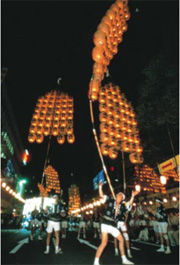 Credit: COURTESY OF AKITA KANTO EXECUTIVE COMMITTEE Akita Kanto Festival (August 3–6)
The Akita Kanto Festival is held in Akita City, Akita Prefecture. A kanto is a bamboo pole hung with paper lanterns. Kanto's can be as large as 12 m in height, carrying forty-six paper lanterns and weighing 50 kg. The people that carry these kanto, sashite, parade through the city. There are around 250 kanto. The magnificent performances by sashite balancing the kanto on their back or shoulder, accompanied by chanting, is very exciting for spectators. |
 Credit: COURTESY OF YAMAGATA HANAGASA COMMITTEE Yamagata Hanagasa Festival (August 5–7)
The Yamagata Hanagasa Festival is held in Yamagata City, Yamagata Prefecture. A hanagasa is a hat decorated with Yamagata's own safflowers. During the Yamagata Hanagasa Festival, around 10,000 dancers parade through the city dressed in attractive outfits, dancing while holding their hanagasa. These dancing groups are incredibly impressive, dancing in perfect unison accompanied by mighty chants and majestic music. |
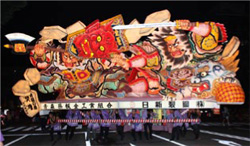 Credit: COURTESY OF AOMORI NEBUTA EXECUTIVE COMMITTEE Aomori Nebuta Festival (August 2–7)
Every year approximately 3 million tourists come to the Aomori Nebuta Festival in Aomori City, Aomori Prefecture. Nebuta are paper models constructed in the likeness of kabuki characters or historical figures, fictional beasts, or gods and such. The largest are around 9 m wide, 5 m tall and 7 m deep. About forty of these multi-colored nebuta are mounted on floats and paraded around the city accompanied by music from flutes and drums in a dynamic display. Dancers called haneto (jumping people) are a feature of this festival. As long as you are wearing a haneto costume, anyone can participate as a haneto without any registration ahead of time necessary. |
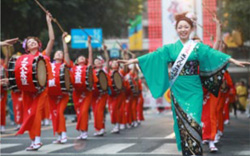 Credit: COURTESY OF ORGANIZAING COMMITTEE OF MORIOKA SANSA ODORI FESTIVAL Morioka Sansa Odori Festival (August 1–4)
The Morioka Sansa Odori is a festival held in Morioka City, Iwate Prefecture. The festival was started in 1978 to introduce in Morioka a new Sansa dance based on the traditional dances that have been performed throughout the areas surrounding Morioka since the Edo period (1603–1867). The highlight is the more than 30,000 dancers from over 200 groups dancing in rhythm to flutes and drums. |
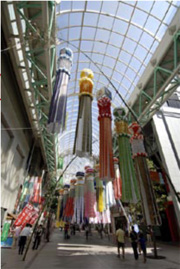 Sendai Tanabata Festival (August 6–8)
Tanabata festivals are held nationwide in the summer, but the Sendai Tanabata Festival is the biggest and most elaborate, famous in particular for the huge fukinagashi decorations which line the city's streets (see story below). The event derives from a Chinese legend in which a married couple, Hikoboshi (Altair) and Orihime (Vega), who have been separated, are able to cross the Milky Way and meet on July 7. In Japan, on either July 7 or August 7 (in the case of Sendai), people write a wish on a tanzaku (strip of paper), tie it to a bamboo branch, and pray for the wish's fulfillment. |
 Credit: COURTESY OF FUKUSHIMA WARAJI MATSURI Fukushima Waraji Matsuri (August 6)
Fukushima Waraji Matsuri is held in Fukushima City, Fukushima Prefecture. Waraji are sandals woven from straw. At the start of the festival, Japan's largest waraji, measuring 12 m and weighing 2 tons, is dedicated at the festival grounds. Afterwards, timed Waraji Races are run down the streets of the city, with people pulling 3.5 m, 130 kg waraji or 850 kg portable shrines. Many citizens also participate in the festival by enthusiastically performing Waraji Dances. |
Giant Streamers for the Stars
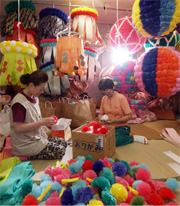
Women making sasakazari for the Tanabata Festival at Narumiya Kamishoji in Sendai
Credit: MASATOSHI SAKAMOTO
These are fukinagashi streamers for the Sendai Tanabata Festival to be held from August 6 to 8 in Sendai. Sendai is famous for its fukinagashi, which reach 4 meters in height, decorated with a kusudama at the very top and long thin strips of Japanese paper or cranes hanging down from it.
Fukinagashi were originally just one of seven traditional sasakazari decorations used during Tanabata festivals, but they are by far the most popular decoration used in the Sendai festival. Sasazakari are bamboo branches adorned with mini lanterns, robes and other objects made from paper. During the Sendai Tanabata Festival, around 3,000 sasakazari are on display throughout the city.
Ranko Yamamura of Narumiya Kamishoji says, "Even though our company's building was damaged in the earthquake, we had absolutely no intention to stop making the Tanabata Festival decorations. Before the quake as well as after, our conviction as professionals to make solid decorations hasn't changed in the least."
Narumiya Kamishoji produces about two-thirds of the sasakazari that decorate the city. During the months of June and July leading up to the festival, the work goes on outside the Narumiya Kamishoji workshop as well, with around 100 people producing them in their homes.
"Since the earthquake, I haven't noticed a particular decline in tourists, but I'm hoping that the Tanabata Festival will be an opportunity to attract even more tourists to Sendai," says Yamamura.
© 2009 Cabinet Office, Government of Japan






